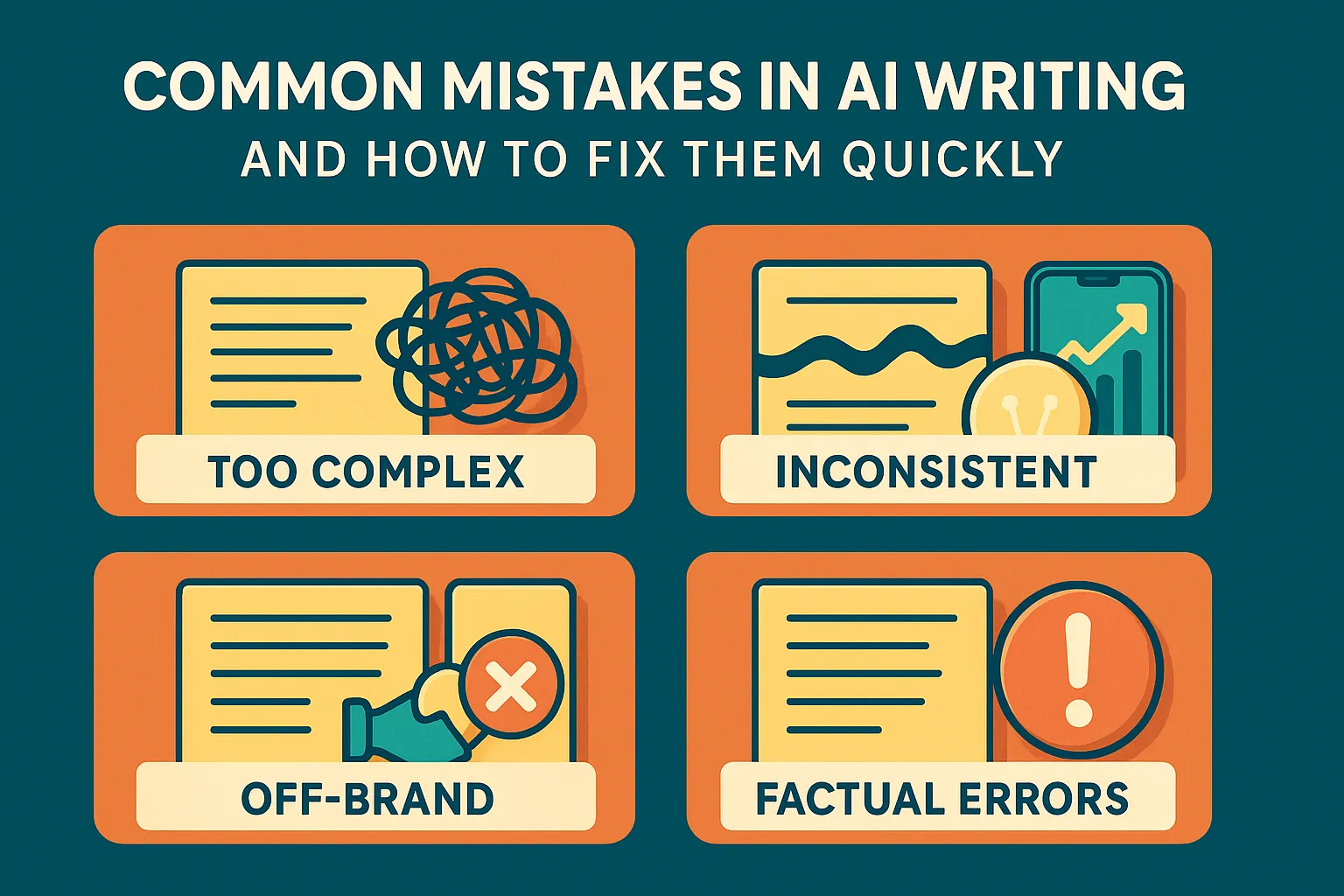Common Mistakes in AI Writing and How to Fix Them Quickly

Artificial Intelligence is changing the manner in which we write. From writing emails to writing full-length articles, AI writing programs can accomplish mind-boggling levels of speed and productivity.
But for goodness' sake, AI is no magic wand. Yes, it's powerful, but the AI-written content falls short of the human touch to actually have an impact. Utilizing too much raw AI output can lead to some of the common errors that make your writing appear clunky, impersonal, or even incorrect.
The good news? Most of these mistakes are easy to spot and quick to fix. By understanding these common blunders, you can transform AI-generated text from merely "okay" to genuinely engaging and effective. Let's continue reading!
1. The Robotic Tone and Lack of Personality
The issue that appears most frequently involves this matter. AI-generated text appears rigid and overly formal, while it lacks any authentic personal touch. The artificial text demonstrates proper grammar and diverse vocabulary yet it fails to convey the emotional depth or human connection which readers need. The delivery of sentences seems awkward, and the entire experience feels irregular.
Why It’s a Problem: Readers connect with authenticity. If your content sounds like it was written by a machine (even a very smart one), it creates a barrier. People are less likely to trust, engage with, or remember content that feels impersonal.
Quick Fixes:
- Read it Aloud: This is the simplest yet most effective trick. If it sounds unnatural when you say it, it will read unnaturally too.
- Inject Your Voice: Think about how you would explain the topic to a friend. Add contractions (it's, you're, we'll), use simpler, more conversational language, and don't be afraid to insert a relevant personal anecdote or opinion (where appropriate).
- Use a Humanizing Tool: Sometimes, the text needs a more thorough overhaul to sound natural. This is where you might want to Humanize AI generated output more systematically. Specialized tools can help rephrase sentences, adjust tone, and smooth out robotic phrasing, saving you significant editing time while ensuring the content resonates better with your audience.
2. Repetitive Language and Sentence Structures
AI models, especially older or less sophisticated ones, can fall into patterns. You might notice the same words or phrases appearing too often, or sentences that all start the same way or follow an identical structure.
Why It’s a Problem: Repetition makes content boring and predictable. It can also make the writing feel lazy or unsophisticated, dulling your message and causing readers to lose interest.
Quick Fixes:
- Vary Sentence Starters: Actively look for sentences beginning with the same word (e.g., "The," "It," "This") and rephrase them.
- Use a Thesaurus (Sparingly): Find synonyms for overused words. But be careful not to swap simple words for overly complex ones just for the sake of variety – clarity is still key.
- Combine and Break Up Sentences: Mix short, punchy sentences with longer, more descriptive ones to create a better rhythm and flow.
3. Factual Inaccuracies or "Hallucinations"
AI models are trained on vast amounts of data, but they don't "know" things in the human sense. Sometimes, they can confidently present information that is outdated, incorrect, or completely fabricated – often called "AI hallucinations."
Why It’s a Problem: Publishing inaccurate information can severely damage your credibility and trustworthiness. In some fields, it can even have serious consequences.
Quick Fixes:
- Fact-Check Everything: Treat AI-generated facts, statistics, dates, and names as claims that need verification from reliable sources.
- Use AI as a Starting Point, Not a Final Source: Let AI generate ideas or a first draft, but always layer in your own expertise and research for factual accuracy.
4. Ignoring the Target Audience
AI doesn't inherently understand who you're trying to reach. It might produce content that's too technical for a general audience, too simplistic for experts, or uses a tone that doesn't align with your brand or the reader's expectations.
Why It’s a Problem: If your content doesn't speak your audience's language or address their specific needs and interests, it won't be effective. They'll tune out or look elsewhere.
Quick Fixes:
- Define Your Audience Clearly (in your prompt and in your mind): Before you even start with AI, know who you're writing for. Are they beginners, experts, customers, or colleagues?
- Tailor the Language: Adjust the vocabulary, complexity, and tone. For example, avoid jargon if you're writing for a lay audience.
5. Overly Complex or Generic, Uninspired Content
Sometimes, in an effort to sound authoritative, AI can produce overly dense paragraphs filled with complex sentences and jargon. Conversely, it can also generate very generic, surface-level content that lacks depth, originality, or any real insight.
Why It’s a Problem: Complex content is hard to read and understand, leading to reader fatigue. Generic content is forgettable and fails to offer real value or stand out from the crowd.
Quick Fixes:
- Add Specific Examples and Unique Insights: Generic statements are weak. Back them up with concrete examples, data, case studies, or your own original thoughts and analysis. This is where your human expertise truly adds value.
- Focus on the "Why": Don't just present information; explain why it matters to the reader. What's the takeaway? How can they use this information?
Concluding Thoughts
AI writing assistants are incredibly valuable for brainstorming, overcoming writer's block, and speeding up the content creation process. However, the best results always come from a partnership between human intelligence and artificial intelligence.
By being aware of these common mistakes and applying these quick fixes, you can harness the power of AI to create content that is not only efficiently produced but also clear, engaging, accurate, and truly resonant with your audience. Happy writing!